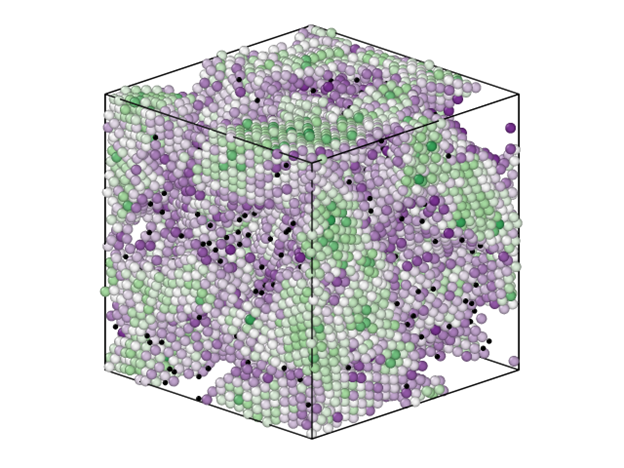Activity-Enhanced Self-Assembly of Colloidal-based Materials
Activity-Enhanced Self-Assembly of Colloidal-based Materials
Associate Professor Klotsa is leading a multi-University team between UNC-Chapel Hill, Caltech and NYU that got awarded a Department of Energy grant from the Biomolecular Materials Program to study Activity-Enhanced Self-assembly of Colloidal-Based Materials (DE-SC0023001).
Daphne Klotsa (UNC-Chapel Hill), John Brady (Caltech) and David Pine (NYU) explain that the emerging field of active matter, has given us the ability to intentionally drive and dynamically manipulate individual particles in synthetic systems. Chemically-coated colloids and nanoparticles can self-propel or ‘swim’ in a directed way via a chemical fuel source and/or light activation. Harnessing such control on the particle level has the potential to revolutionize and accelerate materials discovery and development in an entirely new way, addressing the scope and goals of the DoE and the Biomolecular materials program. Doping of a material with active particles can speed up the assembly process by overcoming kinetic barriers, can increase the “effective local temperature” causing a rearrangement and annealing of defects, and can drive the system to completely new structures and pathways inaccessible through equilibrium processes. Active-particle doping can provide unprecedented control over the assembly process and thus materials properties through controlled and targeted dynamic manipulation of individual particles.

Biology avoids kinetic traps by having an internal energy source – biological self-assembly is inherently non-equilibrium—chemical energy is consumed. Not only can this internal input of energy help free the system from traps, it can also drive the system to entirely new non-equilibrium states or structures that cannot be obtained by thermodynamics alone. Can we emulate nature by using active, rather than passive, colloidal particles as one of our building blocks? The active-matter framework provides an abundance of tools from equilibrium and nonequilibrium statistical physics, and nonlinear dynamics. Yet none of these have been applied to experimentally build more complex and technologically-relevant crystals, as proposed here. However, so far, most studies have focused on assembling proof-of-principle, crystalline monolayers. There are currently no experiments using active dopants for self-assembly in 3D. At the same time, progress in colloidal synthesis (functionalized DNA patches, etc.) has produced remarkable assemblies, such as alloys, clathrates and other open-pore structures, even diamond. With colloids it remains a challenge to assemble sufficiently large low-defect structures that can be used in materials applications. Our goal is to test the vision to create new materials and design strategies of both active-matter and colloidal self-assembly communities. We aim to understand the fundamental science in order to drive the discovery and development of a new generation of materials by utilizing active dopants. The parameter space is immense, which is why our multidisciplinary team includes expertise in theory, simulation and experiment and why continuous synergy and feedback amongst PIs is essential for the success of the project.

Applications with broad societal impact include making colloidal materials with a photonic bandgap, enabled by the recent self-assembly of colloidal diamond, which can be used as optical waveguides, filters and laser resonators, and for improving light-harvesting technologies. Recently assembled colloidal clathrates are useful for encapsulating nanoparticles and proteins, just as molecular clathrates trap molecules such as methane. The approach outlined in the current proposal will impact the scientific community by creating a new paradigm: bridging expertise in colloidal self-assembly with the latest active-matter research in order to discover and experimentally develop new materials. Results from the proposal will open up new routes in self-assembly strategies to include active dopants and provide the essential fundamental physics/chemistry, as well as design rules for the conceptual, experimental and practical challenges.

